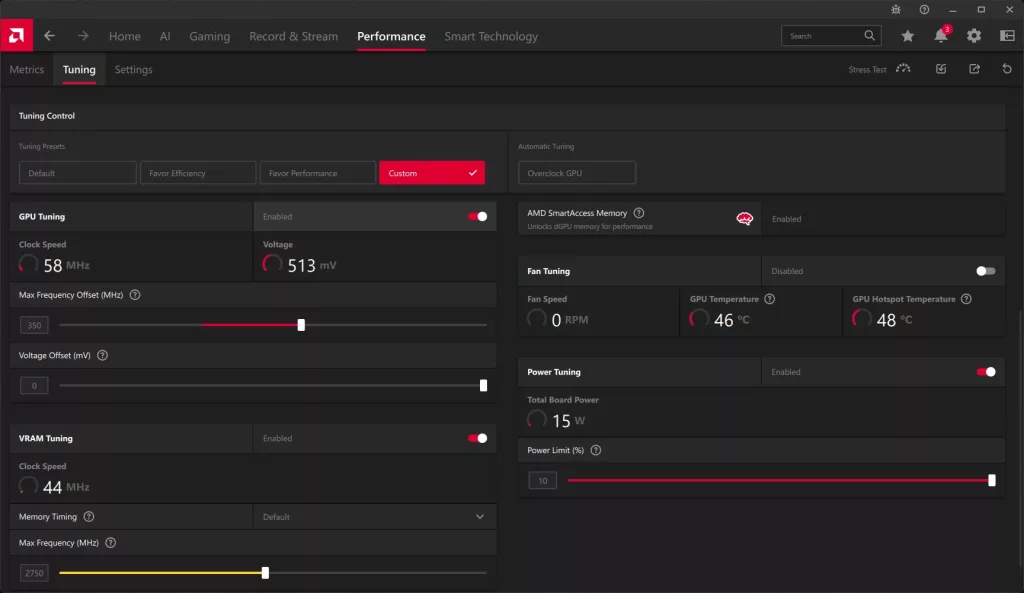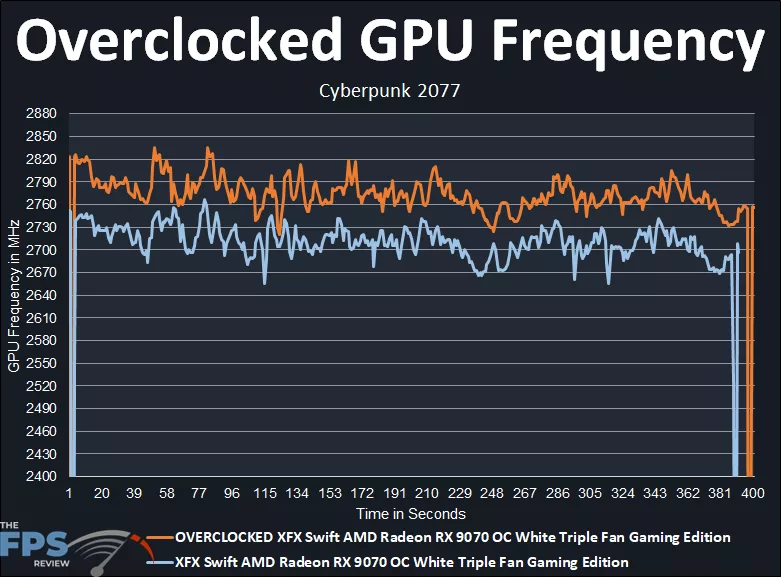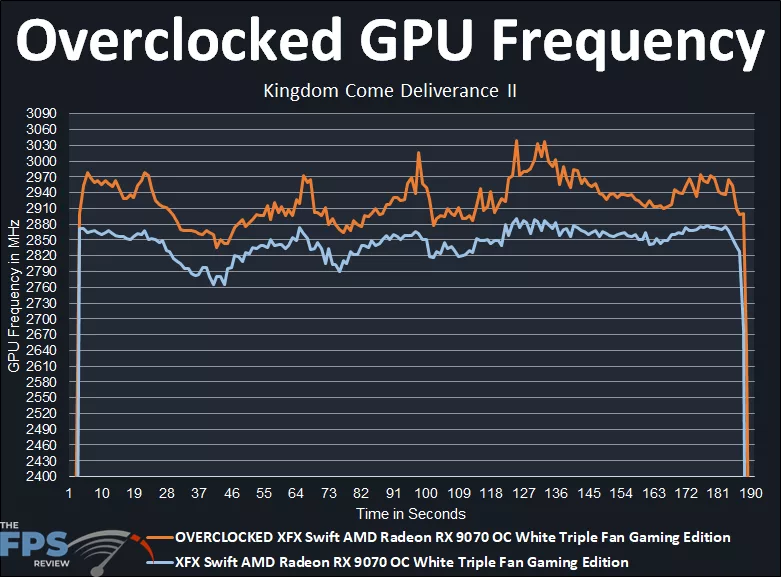Overclocking XFX Swift AMD Radeon RX 9070 OC White Triple Fan Gaming Edition
To overclock the XFX Swift AMD Radeon RX 9070 OC White Triple Fan Gaming Edition video card, we turned to AMD Radeon Adrenalin Software and the Performance Tuning menu to unlock custom performance tuning to adjust the Max Boost, Memory, and Power Limit.

In the screenshot above, you will see our highest stable overclock on the XFX Swift AMD Radeon RX 9070 OC White Triple Fan Gaming Edition video card. Let’s walk through some of the settings. First, we were able to increase the Power Limit by just 10%, so that does not give us a tremendous amount of power headroom, just a little bit, but not a lot. As we found out, power limiting is a major factor in the video card being able to hit its higher boost clocks and overclock past the boost clock.
In terms of adjusting the GPU frequency, for this generation on the Radeon RX 9070, much like the Radeon RX 9070 XT, it seems the only slider we have available is the Max Frequency Offset slider. Gone is the Minimum Frequency slider, which we used in the last generation video card primarily to overclock with. Now, all we can do is push up the Max Frequency Offset as far as possible. We also cannot increase the Voltage Offset, which is locked for us here, and all we can do is undervolt Voltage. We can, however, adjust the memory up pretty far; there is a lot of headroom on the slider for high memory, past what we found stable.
Our maximum overclock resulted in the Max Frequency Offset slider of +350MHz, and the memory set at 2750MHz (x8 = 22Gbps) compared to the default 20Gbps. With the memory at 22Gbps, memory bandwidth increases to 704GB/s from the default 644GB/s of bandwidth.
GPU Frequency
Before we dive into the GPU Frequency, we noted some interesting behavior to report. We found that the GPU Frequency can boost differently depending on the game and resolution. For example, we got a higher reported frequency in Kingdom Come Deliverance II and some other games, and then in some other games like Cyberpunk 2077 (which we mostly use for power and temp testing), the frequency was lower. This means that we need to show both games to you below.
In addition, we found that higher resolutions have a lower GPU Boost frequency when gaming compared to lower resolutions like 1440p. The end result is that we need to show you the GPU Frequency in both Cyberpunk 2077 and Kingdom Come Deliverance II, so you can get an idea of the total range the frequency operates within at default and overclocked. Kingdom Come Deliverance II actually pushed the GPU harder in terms of a higher frequency and a higher board power draw due to the frequency being higher.

In the above graph, we are running Cyberpunk 2077 at 1440p, and this is a manual run-through. At default, the XFX Swift AMD Radeon RX 9070 OC White Triple Fan Gaming Edition is operating anywhere from 2670MHz up to 2760MHz peaking, by default. Keep in mind that the turbo boost clock is up to 2700MHz, while the game clock is up to 2210MHz by default on this video card. We don’t often expect the turbo clock to be reached in gaming, but it can sometimes.
At any rate, the XFX Swift AMD Radeon RX 9070 OC White Triple Fan Gaming Edition is operating in that ballpark of the turbo clock frequency while gaming here in Cyberpunk, and this was on the low side, as we mentioned in Kingdom Come Deliverance II the frequency was higher. If we take the average of the default clock speed, it comes out to be: 2705MHz, so hitting that turbo clock here in this game.
When we overclock the XFX Swift AMD Radeon RX 9070 OC White Triple Fan Gaming Edition to +350 on the Maximum Frequency slider, we do see the clock speed increase. It is now hitting between 2730MHz-2820MHz while gaming. If we take the average of the clock speed we experienced that comes out to: 2767MHz. Therefore, in this game, which again is on the lower side, is an overclock of 2.2% average, or 62MHz average, but let’s look at Kingdom Come Deliverance II below which overall shows higher frequencies.

In Kingdom Come Deliverance II, you will now notice that the default frequency is between 2760MHz-2880MHz while gaming. If we take the average of that, it comes out to: 2820MHz average at default, which is higher than the Cyberpunk 2077 frequencies shown. That puts the default clock speed well over the turbo clock of 2700MHz here.
When we overclock the XFX Swift AMD Radeon RX 9070 OC White Triple Fan Gaming Edition we see a clear advantage in frequency, now ranging from 2830MHz-3030MHz at the peak! If we take the average of that, it comes out to: 2899MHz which is a 3% GPU overclock average or 79MHz. While this isn’t a large overclock, it is consistently higher throughout the gaming session and we see it reaching near 2900MHz average when overclocked, which is well over the AMD reference turbo clock of 2520MHz at any rate.
